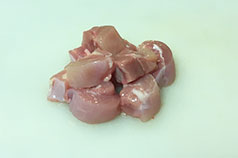
Boneless Chicken Thigh
Chicken thigh is upper part of the leg, and is used to cook variety of dishes all over the world. Since it is dark colored meat, it has more flavor, and it remains juicy and tender when cooked on high heat or slow cooked. Chicken thigh can be used in many ways to prepare dishes. These can be roasted, grilled, sauteed, pan-fried, baked or curried.
Chicken thigh has more muscle and fat - 4 ounces of boneless and skinless chicken thigh has 69% protein, 31% fat, and 0% carbohydrates. Both dark and white chicken meat is a good source of proteins, vitamins A, K, B6, B12, folate, niacin, and minerals such as iron, selenium, phosphorus, and zinc.
Buy chicken with USDA organic seal to make sure that the chicken is raised on food that does not contain animal by-products and is not raised with antibiotics.
Chicken thigh has more muscle and fat - 4 ounces of boneless and skinless chicken thigh has 69% protein, 31% fat, and 0% carbohydrates. Both dark and white chicken meat is a good source of proteins, vitamins A, K, B6, B12, folate, niacin, and minerals such as iron, selenium, phosphorus, and zinc.
Buy chicken with USDA organic seal to make sure that the chicken is raised on food that does not contain animal by-products and is not raised with antibiotics.

Garlic Cloves
Native to central Asia, Garlic is one of the earliest plants that human used for flavoring food dishes as well as maintaining a good health. Garlic became an important ingredient in cooking many dishes in various parts of the world, such as, Asian countries including Middle East, northern Africa, southern Europe, and parts of South and Central America. However, Garlic was not popular in the USA until the beginning of twentieth century. By the year 1940, Americans recognized the importance of Garlic and started using it to season various recipes.
A Garlic bulb is a bunch of individual segments called cloves (like an orange segment). Each Garlic clove can be separated off the bunch and peeled before use to flavor any recipe. A Garlic clove can be used as a whole, sliced, crushed, or in the form of paste. Each way of using Garlic provides a different flavor to the recipes. For example, whole and sliced garlic provides mild taste than crushed and paste form.
Due to higher concentration of fructose and significantly less water content, Garlic is browned quickly when frying or roasting. Therefore, Garlic needs to be cooked carefully. If you are cooking food in a pan or a wok, one way is to add Garlic toward the end of cooking, in the last few minutes. However, Garlic added at the end of the cooking will provide a stronger taste. Some people like it, some don’t. Cooking Garlic at the beginning will mellow down the strong taste. To add garlic at the beginning of cooking and yet prevent from burning, cook the Garlic at a low heat and preferably in a smaller pan or wok. You can change the heat from low to medium after adding other ingredients with garlic. Garlic cooked this way will provide mild taste to the food. Garlic is best roasted in an oven by wrapping the cloves or whole bulb in an aluminum foil at 400 degrees Fahrenheit for about 40 minutes.
Though garlic is best known for flavoring food, it has also been used to maintain good health and for increasing strength. Usage of garlic in food may also help prevent many heart and blood system related conditions, such as, high blood pressure, high cholesterol, and coronary heart disease. It’s also believed that consumption of garlic on a regular basis reduces the risk of getting certain cancer, such stomach cancer, colon cancer, and lung cancer. For maximum health benefits, slice, crush, or make garlic paste 10 minutes before cooking. When a garlic clove is broken down, the ruptured cell releases the sulphur-based compound, alliin and an enzyme called alliinase. They come in contact with each other to form a new compound called alliicin, which is responsible for medicinal properties of Garlic. Allowing the cut Garlic to sit for about 10 minutes before cooking provides maximum health benefits due to optimal synthesis of alliicin.
Whole fresh garlic should be stored at room temperature at dry and dark place with proper ventilation. Do not store garlic in closed plastic bags. It’s best to store garlic in netted or punched bags for better air circulation. Refrigeration or freezing changes the texture and flavor of garlic. However, cut or peeled garlic needs to sealed in a container or air tight bag and refrigerated for later use.
A Garlic bulb is a bunch of individual segments called cloves (like an orange segment). Each Garlic clove can be separated off the bunch and peeled before use to flavor any recipe. A Garlic clove can be used as a whole, sliced, crushed, or in the form of paste. Each way of using Garlic provides a different flavor to the recipes. For example, whole and sliced garlic provides mild taste than crushed and paste form.
Due to higher concentration of fructose and significantly less water content, Garlic is browned quickly when frying or roasting. Therefore, Garlic needs to be cooked carefully. If you are cooking food in a pan or a wok, one way is to add Garlic toward the end of cooking, in the last few minutes. However, Garlic added at the end of the cooking will provide a stronger taste. Some people like it, some don’t. Cooking Garlic at the beginning will mellow down the strong taste. To add garlic at the beginning of cooking and yet prevent from burning, cook the Garlic at a low heat and preferably in a smaller pan or wok. You can change the heat from low to medium after adding other ingredients with garlic. Garlic cooked this way will provide mild taste to the food. Garlic is best roasted in an oven by wrapping the cloves or whole bulb in an aluminum foil at 400 degrees Fahrenheit for about 40 minutes.
Though garlic is best known for flavoring food, it has also been used to maintain good health and for increasing strength. Usage of garlic in food may also help prevent many heart and blood system related conditions, such as, high blood pressure, high cholesterol, and coronary heart disease. It’s also believed that consumption of garlic on a regular basis reduces the risk of getting certain cancer, such stomach cancer, colon cancer, and lung cancer. For maximum health benefits, slice, crush, or make garlic paste 10 minutes before cooking. When a garlic clove is broken down, the ruptured cell releases the sulphur-based compound, alliin and an enzyme called alliinase. They come in contact with each other to form a new compound called alliicin, which is responsible for medicinal properties of Garlic. Allowing the cut Garlic to sit for about 10 minutes before cooking provides maximum health benefits due to optimal synthesis of alliicin.
Whole fresh garlic should be stored at room temperature at dry and dark place with proper ventilation. Do not store garlic in closed plastic bags. It’s best to store garlic in netted or punched bags for better air circulation. Refrigeration or freezing changes the texture and flavor of garlic. However, cut or peeled garlic needs to sealed in a container or air tight bag and refrigerated for later use.

Lime Juice
Lime juice or juice extracted from lime is a great source of vitamin C and used to add tartness and freshness to food and beverages. It also a natural preservative and slows down the spoilage of food. The juice is squeezed from fresh cut lime or bought readymade at grocery stores or supermarkets.
Best quality lime is bright deep green in color and is firm and heavy for its size. More ripen lime turn yellow in color; however it is best when green. Lime produces more juice when warmer. Therefore, to get the most juice out of lime, bring it to room temperature (if refrigerated) and roll it under your palm against a hard surface to warm it more, before squeezing. Another quick method is to microwave it for 15-30 seconds, let it sit for a few minutes before cutting and squeezing.
In addition to its use in food and drinks, lime juice also provides health benefits that include weight loss, skin care, and improved digestion. Due to the presence of significant amount of vitamin C, it helps in curing scurvy, which is caused due to vitamin C deficiency. Vitamin C in lime juice also acts as an antioxidant and helps in strengthening the immune system.
Lime or packaged lime juice is available in grocery stores throughout the year. Lime will stay fresh for a week at room temperature when kept away from sunlight. You can also store it in your refrigerator’s crisper tray for about a month, if bought fresh.
Best quality lime is bright deep green in color and is firm and heavy for its size. More ripen lime turn yellow in color; however it is best when green. Lime produces more juice when warmer. Therefore, to get the most juice out of lime, bring it to room temperature (if refrigerated) and roll it under your palm against a hard surface to warm it more, before squeezing. Another quick method is to microwave it for 15-30 seconds, let it sit for a few minutes before cutting and squeezing.
In addition to its use in food and drinks, lime juice also provides health benefits that include weight loss, skin care, and improved digestion. Due to the presence of significant amount of vitamin C, it helps in curing scurvy, which is caused due to vitamin C deficiency. Vitamin C in lime juice also acts as an antioxidant and helps in strengthening the immune system.
Lime or packaged lime juice is available in grocery stores throughout the year. Lime will stay fresh for a week at room temperature when kept away from sunlight. You can also store it in your refrigerator’s crisper tray for about a month, if bought fresh.
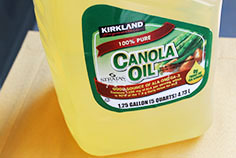
Canola Oil
Coming Soon...
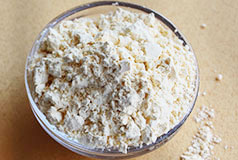
Gram Flour
Coming Soon...
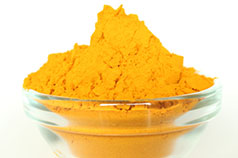
Turmeric Powder
Turmeric powder is a bright and deep yellow colored powder made by grinding dried underground stems of turmeric, which is starchy in nature. In India and some of its neighboring countries, turmeric in stem or powdered form has been used to color skin and clothing and to add color and aroma to food. It is also used as a pious powder during festivals and marriage ceremonies. In other parts of the world, turmeric is mainly used to add color and aroma to food. Turmeric has pungent and bitter taste but musky and mild fragrance.
Turmeric powder is made by steaming or boiling the underground stems in slightly alkaline water (measures above 7.0 on the pH scale) to precook the starch in turmeric. The alkaline water also improves the color of turmeric. Boiled turmeric stems are sun-dried and ground to make powder.
Turmeric powder is mainly used in curries, stir fried dishes, and dry rubs. It is also used in some spicy salad dressing and smoothies and drinks.
The compound called curcuminoids in turmeric is responsible for its yellow color and has antioxidant and preservative properties. Due to its antioxidant properties, use of turmeric in food helps prevent certain type of cancer, lowers cholesterol, lowers the risk of cardiovascular diseases, and protects from Alzheimer’s disease. Due to its preservative property, use of turmeric in food helps in extending the shelf-life of food.
Turmeric has also been used in Indian and Chinese system of medicine as an anti-inflammatory agent to treat various conditions such as toothache, bruises, chest pain, and digestion problems. In addition, turmeric contains very good amounts of minerals like iron, calcium, potassium, manganese, zinc, copper, and magnesium.
Store turmeric powder in a tightly sealed container in a cool, dark, and dry place. At room temperature, turmeric powder will taste fresh for 4 to 6 months. Refrigerate it for a longer shelf-life of up to 2 years.
Turmeric powder is available in Indian and South Asian grocery stores. Some of the popular brands of turmeric powder are Nirav, Deep, SWAD, Spicy World, and Jiva. You may also find it in supermarkets or gourmet markets. It is available at online grocery stores such as amazon.com, where you will be able to choose from several brands.
Turmeric powder is made by steaming or boiling the underground stems in slightly alkaline water (measures above 7.0 on the pH scale) to precook the starch in turmeric. The alkaline water also improves the color of turmeric. Boiled turmeric stems are sun-dried and ground to make powder.
Turmeric powder is mainly used in curries, stir fried dishes, and dry rubs. It is also used in some spicy salad dressing and smoothies and drinks.
The compound called curcuminoids in turmeric is responsible for its yellow color and has antioxidant and preservative properties. Due to its antioxidant properties, use of turmeric in food helps prevent certain type of cancer, lowers cholesterol, lowers the risk of cardiovascular diseases, and protects from Alzheimer’s disease. Due to its preservative property, use of turmeric in food helps in extending the shelf-life of food.
Turmeric has also been used in Indian and Chinese system of medicine as an anti-inflammatory agent to treat various conditions such as toothache, bruises, chest pain, and digestion problems. In addition, turmeric contains very good amounts of minerals like iron, calcium, potassium, manganese, zinc, copper, and magnesium.
Store turmeric powder in a tightly sealed container in a cool, dark, and dry place. At room temperature, turmeric powder will taste fresh for 4 to 6 months. Refrigerate it for a longer shelf-life of up to 2 years.
Turmeric powder is available in Indian and South Asian grocery stores. Some of the popular brands of turmeric powder are Nirav, Deep, SWAD, Spicy World, and Jiva. You may also find it in supermarkets or gourmet markets. It is available at online grocery stores such as amazon.com, where you will be able to choose from several brands.

Ginger
Native to Southeastern Asia, Ginger is popularly used as a spice and medicine in both eastern and western cultures. Ginger was used by ancient Romans and later, after the fall of Roman Empire, was traded in Europe by Arabs who took over the spice trade. Ginger became very expensive like other spices, and in medieval times, was traded in preserved form to make sweet treats.
For many years, ginger has been used to flavor a wide variety of food, from meats and sausages to fish and vegetables, and various curries as well as drinks and desserts. Fresh ginger can be used as sliced, crushed, or as paste.
Ginger has antioxidant and anti-inflammatory properties; therefore, it’s used in traditional medicine to cure a variety of ailments, such as, gastrointestinal distress, motion sickness, arthritis, and cold and flu. Cooking food with small quantity of ginger on a regular basis also adds to health benefits.
The distinct flavor and medicinal property of ginger comes from gingerols, shogaols, and zingerone. Fresh ginger contains gingerol an anti-inflammatory compound that is believed to help in reducing osteoarthritis or rheumatoid arthritis pain, if consumed on a regular basis. It may also prevent growth of certain cancer. Gingerol is transformed into shogaols when dried and cooked. Also, when ginger is cooked gingerol and shogaols is transformed into zingerone. Due to the presence of zingerone, food cooked with ginger has a sweet and spicy flavor. The anti-inflammatory and antioxidant properties of zingerone help in prevention and cure of many medical problems. Dry ginger alone has strong flavor due to shogaols used in many medicines as well as compliments cookies, cakes, and candies recipes, and tea and drinks.
In addition to the use for culinary and medicinal purposes, ginger is also used to fragrance many soaps and cosmetics.
Ginger is sold in many forms in supermarkets, such as fresh, dried, powdered, preserved, crystallized, and as oil. You will find ginger paste, a popular way of using ginger to make curries in Asian countries, in Asian and South Asian grocery stores. Be sure to use ginger in the recipe in the form it’s advised. For example, if a recipe calls for fresh ginger, it cannot be replaced with dry or powdered or other types. Each form of ginger has a distinct taste and different purpose.
Ginger is best stored as whole and unpeeled in a sealed plastic bag in refrigerator. If part of the ginger has been cut or peeled, be sure to dry it before storing. Other forms of ginger are mainly packaged and need to be stored as per instructions by the seller.
For many years, ginger has been used to flavor a wide variety of food, from meats and sausages to fish and vegetables, and various curries as well as drinks and desserts. Fresh ginger can be used as sliced, crushed, or as paste.
Ginger has antioxidant and anti-inflammatory properties; therefore, it’s used in traditional medicine to cure a variety of ailments, such as, gastrointestinal distress, motion sickness, arthritis, and cold and flu. Cooking food with small quantity of ginger on a regular basis also adds to health benefits.
The distinct flavor and medicinal property of ginger comes from gingerols, shogaols, and zingerone. Fresh ginger contains gingerol an anti-inflammatory compound that is believed to help in reducing osteoarthritis or rheumatoid arthritis pain, if consumed on a regular basis. It may also prevent growth of certain cancer. Gingerol is transformed into shogaols when dried and cooked. Also, when ginger is cooked gingerol and shogaols is transformed into zingerone. Due to the presence of zingerone, food cooked with ginger has a sweet and spicy flavor. The anti-inflammatory and antioxidant properties of zingerone help in prevention and cure of many medical problems. Dry ginger alone has strong flavor due to shogaols used in many medicines as well as compliments cookies, cakes, and candies recipes, and tea and drinks.
In addition to the use for culinary and medicinal purposes, ginger is also used to fragrance many soaps and cosmetics.
Ginger is sold in many forms in supermarkets, such as fresh, dried, powdered, preserved, crystallized, and as oil. You will find ginger paste, a popular way of using ginger to make curries in Asian countries, in Asian and South Asian grocery stores. Be sure to use ginger in the recipe in the form it’s advised. For example, if a recipe calls for fresh ginger, it cannot be replaced with dry or powdered or other types. Each form of ginger has a distinct taste and different purpose.
Ginger is best stored as whole and unpeeled in a sealed plastic bag in refrigerator. If part of the ginger has been cut or peeled, be sure to dry it before storing. Other forms of ginger are mainly packaged and need to be stored as per instructions by the seller.
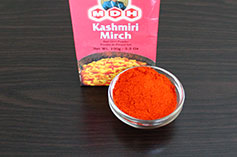
Kashmiri Red Chili Powder
Coming Soon...

Salt
Salt is a mineral composed of a chemical compound called sodium chloride. It is essential for human body to regulate fluid balance and to control function of nerves and muscles. Human body cannot produce its own salt and depends on various sources of salt in food for necessary daily intake.
In addition to being just a diet supplement, salt helps in extracting the real flavors of savory as well as sweet dishes. No other seasoning has been found so fulfilling to replace salt. However, the overuse of salt results into a lot of health problems, such as hypertension, heart disease, and strokes. Use salt mildly in your food to you can enjoy its goodness.
In addition to being just a diet supplement, salt helps in extracting the real flavors of savory as well as sweet dishes. No other seasoning has been found so fulfilling to replace salt. However, the overuse of salt results into a lot of health problems, such as hypertension, heart disease, and strokes. Use salt mildly in your food to you can enjoy its goodness.
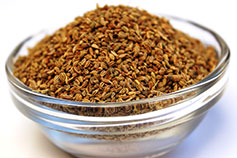
Carom Seeds
Coming Soon...

Yogurt
Coming Soon...
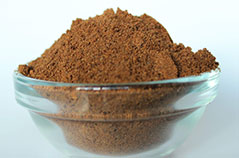
Garam Masala Powder
An authentic garam masala is a collection of four spices either in whole or powdered form. The four spices, green cardamom, black cardamom, clove, and cinnamon stick added in the right proportion enhances the flavor and aroma of the dishes. The word ‘garam’ means warm or hot and ‘masala’ means spice; however, garam masala does not mean that the spices are hot. It means that the spices raise your body temperature by increasing the metabolism. The taste of garam masala in food is intense (not hot) yet pleasant.
Either in whole or powdered form, it is an essential ingredient in many Indian and South Asian cuisine. The whole garam masala is usually added to the hot oil before other ingredients to release its flavor to the oil. On the other hand, the garam masala powder is added to the dishes with other powdered spices while cooking or just for seasoning the dishes toward the end of the cooking. Garam masala is used to flavor a variety of curries, stews, and soups and marinades and rubs for barbecue. Green cardamom, cinnamon, and clove are used to flavor a wide range of desserts.
Readymade garam masala powder is available in Indian or South Asian grocery stores or gourmet markets. However, the readymade masala contains several ingredients in addition to the four basic spices, which makes it not taste exactly like the authentic garam masala. I have tried it once and decided to make my own at home. It tastes good, but does not taste like real garam masala. However, you can go ahead and try to see if you like it.
There are two methods to make garam masala powder at home:
Method 1:
Most grocery stores that sell Indian or South Asian spices, also sell powdered green cardamom, cinnamon, and clove individually in small packets. Go ahead and buy the spices powder and mix them at home in the proportion listed below:
Black Cardamom Powder - 2 tablespoon
Cinnamon Powder – 1 tablespoon
Green Cardamom Powder – 1/2 tablespoon
Clove Powder – 1/2 tablespoon
The above ingredients mixed together will make ½ cup (4 ounces) garam masala powder.
Method 2:
This is the tradition method of making garam masala at home by roasting and grinding the whole garam masala as follows:
Whole black cardamom pods – 6 (Use whole, not shelled)
Whole cinnamon sticks – 5 (3 inches long)
Whole green cardamom pods – 10 (Use whole, not shelled)
Whole cloves - 12
Since we are using whole cardamom pods with shell, the above ingredients together after grinding will make a little more than ½ cup garam masala powder.
Slightly roast or warm the above listed whole spices for about 2-3 minutes and let it cool. Then grind them together in a spice grinder or a coffee grinder designated for grinding spices only. Roasting or warming the spices adds crispness and intensifies the flavor and aroma of the spices. Cool the powdered garam masala before storing.
Store the masala powder in a tight lid jar in a cool, dark, and dry place. It will last for about six months at room temperature. If you do not use it often in your cooking then keep it in the freezer to last up to 2 years.
In addition to the adding wonderful flavor and aroma to the food, garam masala helps in boosting metabolism and promoting weight loss. It helps in absorbing nutrients and lowering blood sugar. It also helps in detoxification.
You can buy whole or powdered garam masala at any Indian or South Asian grocery store or gourmet markets. It is available at online grocery stores such as amazon.com. Type the name of garam masala spice you want to buy on search bar, you will be able to choose from several brands.
Either in whole or powdered form, it is an essential ingredient in many Indian and South Asian cuisine. The whole garam masala is usually added to the hot oil before other ingredients to release its flavor to the oil. On the other hand, the garam masala powder is added to the dishes with other powdered spices while cooking or just for seasoning the dishes toward the end of the cooking. Garam masala is used to flavor a variety of curries, stews, and soups and marinades and rubs for barbecue. Green cardamom, cinnamon, and clove are used to flavor a wide range of desserts.
Readymade garam masala powder is available in Indian or South Asian grocery stores or gourmet markets. However, the readymade masala contains several ingredients in addition to the four basic spices, which makes it not taste exactly like the authentic garam masala. I have tried it once and decided to make my own at home. It tastes good, but does not taste like real garam masala. However, you can go ahead and try to see if you like it.
There are two methods to make garam masala powder at home:
Method 1:
Most grocery stores that sell Indian or South Asian spices, also sell powdered green cardamom, cinnamon, and clove individually in small packets. Go ahead and buy the spices powder and mix them at home in the proportion listed below:
Black Cardamom Powder - 2 tablespoon
Cinnamon Powder – 1 tablespoon
Green Cardamom Powder – 1/2 tablespoon
Clove Powder – 1/2 tablespoon
The above ingredients mixed together will make ½ cup (4 ounces) garam masala powder.
Method 2:
This is the tradition method of making garam masala at home by roasting and grinding the whole garam masala as follows:
Whole black cardamom pods – 6 (Use whole, not shelled)
Whole cinnamon sticks – 5 (3 inches long)
Whole green cardamom pods – 10 (Use whole, not shelled)
Whole cloves - 12
Since we are using whole cardamom pods with shell, the above ingredients together after grinding will make a little more than ½ cup garam masala powder.
Slightly roast or warm the above listed whole spices for about 2-3 minutes and let it cool. Then grind them together in a spice grinder or a coffee grinder designated for grinding spices only. Roasting or warming the spices adds crispness and intensifies the flavor and aroma of the spices. Cool the powdered garam masala before storing.
Store the masala powder in a tight lid jar in a cool, dark, and dry place. It will last for about six months at room temperature. If you do not use it often in your cooking then keep it in the freezer to last up to 2 years.
In addition to the adding wonderful flavor and aroma to the food, garam masala helps in boosting metabolism and promoting weight loss. It helps in absorbing nutrients and lowering blood sugar. It also helps in detoxification.
You can buy whole or powdered garam masala at any Indian or South Asian grocery store or gourmet markets. It is available at online grocery stores such as amazon.com. Type the name of garam masala spice you want to buy on search bar, you will be able to choose from several brands.
Share your thoughts and questions!


